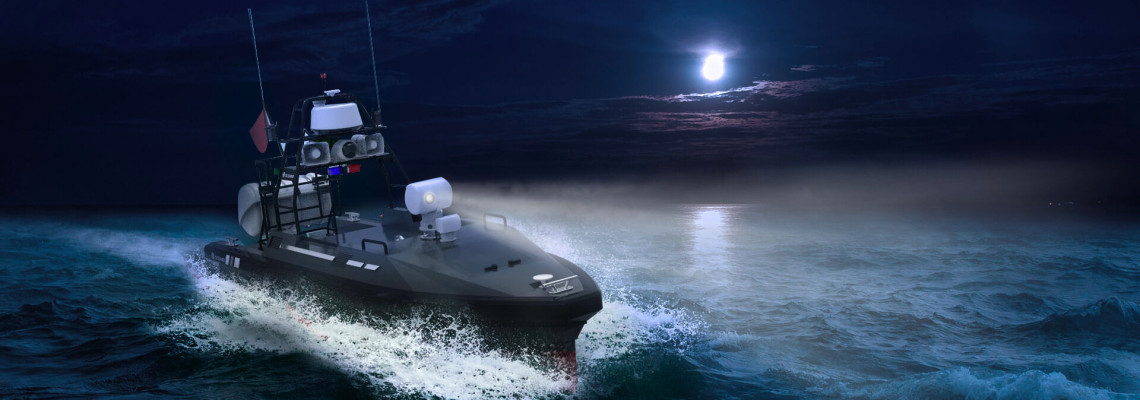
M 75 Un-Crewed Patrol Vessel:
A New Era of Maritime Security
In the ever-evolving world of defense and maritime security, technological advancements play a crucial role in enhancing the effectiveness and safety of naval operations. One of the most groundbreaking innovations in recent years is the M 75 Un-Crewed Patrol Vessel—a fully autonomous, unmanned vessel designed for maritime surveillance and patrol missions.
The M 75 represents a significant leap forward in defense technology, combining the power of unmanned systems with the versatility and durability needed for complex maritime tasks. This innovative vessel is set to redefine the landscape of naval operations, offering an array of benefits such as reduced operational costs, enhanced security, and greater operational flexibility. In this blog, we’ll explore the features, capabilities, and advantages of the M 75 Un-Crewed Patrol Vessel and how it is transforming maritime defense operations.
What is the M 75 Un-Crewed Patrol Vessel?
The M 75 Un-Crewed Patrol Vessel is an advanced, autonomous maritime vehicle designed for a wide range of maritime security applications. It operates without the need for human personnel onboard, relying instead on cutting-edge unmanned systems and artificial intelligence (AI) to navigate, patrol, and perform surveillance tasks autonomously.
The M 75 is primarily used by defense agencies, coast guards, and maritime security forces to monitor territorial waters, detect illegal activities, and enhance national security without putting human lives at risk. Its autonomy, robustness, and adaptability make it ideal for high-risk operations and long-duration patrols, offering capabilities that far surpass traditional manned patrol vessels.
Key Features of the M 75 Un-Crewed Patrol Vessel
Autonomous Operation
The M 75 is fully autonomous, meaning it can operate independently without requiring direct human control. Using advanced AI algorithms, the vessel is capable of navigating through various maritime environments, identifying and classifying potential threats, and executing surveillance tasks.
It can be remotely monitored and controlled if needed, but its autonomy allows for seamless, long-duration missions without the need for crew shifts, reducing the risk to human operators and enhancing operational efficiency.
Advanced Navigation and Sensors
Equipped with state-of-the-art sensors, including radar, sonar, and infrared imaging, the M 75 has superior situational awareness. This allows it to detect and track targets over vast distances, even in challenging conditions such as poor visibility, bad weather, or low-light environments.
The vessel uses GPS technology for precise navigation, ensuring it can follow designated routes and patrol areas accurately. Additionally, the M 75 can use machine learning algorithms to avoid obstacles and safely navigate through busy shipping lanes or near coastal areas.
Modular and Versatile Design
The M 75 boasts a modular design that allows for customization based on mission-specific requirements. Whether conducting surveillance, counter-piracy operations, or search-and-rescue missions, the vessel can be outfitted with various mission modules, including advanced communication systems, weapons systems, or environmental sensors.
Its versatile design allows for quick reconfiguration, ensuring the M 75 can be deployed for a wide array of tasks. Whether on the frontline of a naval blockade or performing coastal surveillance, the vessel can easily adapt to any mission profile.
Stealth and Durability
Built with advanced materials, the M 75 is designed to withstand harsh maritime environments. Its hull is constructed from durable, corrosion-resistant materials, allowing it to endure rough seas and long deployments without compromising operational effectiveness.
Additionally, the vessel’s design minimizes its radar signature, making it difficult to detect by adversaries. This stealth feature is particularly useful in intelligence-gathering missions and operations where remaining undetected is critical.
Long-Endurance and Fuel Efficiency
One of the standout features of the M 75 is its long operational endurance. The vessel can remain at sea for extended periods—ranging from several days to weeks—without requiring resupply or crew changes. Its autonomous systems are designed for energy efficiency, allowing it to operate for longer durations than traditional manned vessels.
The M 75 typically runs on electric or hybrid propulsion systems, making it more fuel-efficient and reducing its environmental footprint. This makes it an ideal solution for sustained patrols, surveillance, and reconnaissance in areas where other vessels would require frequent refueling.
Remote Control and Real-Time Data Transmission
While the M 75 is autonomous, it also features remote-control capabilities. A human operator can take control of the vessel in real-time via a remote control center, allowing for manual intervention when necessary.
The vessel can transmit real-time data, including video feeds, sensor data, and other critical information, to operators, enabling them to make informed decisions on the ground. Whether monitoring illegal fishing activities, tracking ships of interest, or conducting environmental monitoring, the M 75 ensures that decision-makers have access to up-to-date information.
Safety and Risk Mitigation
By removing the need for human operators on board, the M 75 significantly reduces the risks associated with traditional patrol operations. It can operate in hazardous environments, such as near conflict zones, high-piracy areas, or disaster zones, without endangering the lives of military or coast guard personnel.
The vessel is also equipped with advanced safety systems, including emergency response protocols and automatic shutdown features, ensuring that it can handle unexpected challenges autonomously.
Key Advantages of the M 75 Un-Crewed Patrol Vessel
1. Cost Efficiency
Operating and maintaining a manned patrol vessel can be extremely costly, with expenses related to crew salaries, fuel, maintenance, and logistics. The M 75, being an unmanned system, offers significant cost savings by eliminating the need for onboard crew and reducing the operational overhead associated with traditional vessels.
Additionally, the vessel's long operational endurance and fuel-efficient propulsion system reduce costs related to fuel consumption and resupply operations.
2. Enhanced Operational Reach and Flexibility
The M 75 can operate in remote, hard-to-reach areas without the logistical challenges that come with deploying traditional manned ships. It can patrol expansive maritime zones, including exclusive economic zones (EEZs) and contested territorial waters, where the presence of human-operated vessels might be impractical or risky.
Its ability to conduct long-duration operations makes it ideal for continuous surveillance of key maritime areas, ensuring enhanced security and a rapid response capability.
3. Reduced Human Risk in Dangerous Operations
In regions where piracy, illegal fishing, and other maritime crimes are prevalent, deploying human crews in dangerous zones poses a significant risk. The M 75 removes the need for humans to be physically present in high-risk areas, significantly reducing the risk of casualties or capture by hostile forces.
The vessel’s autonomous nature allows it to take on the most hazardous missions, including combat patrols and reconnaissance in contested areas, without endangering personnel.
4. Precision and Intelligence-Gathering
Armed with advanced sensors and imaging systems, the M 75 can gather critical intelligence and provide high-resolution surveillance data. It can monitor ship movements, identify illegal activities, or detect environmental hazards like oil spills or maritime pollution, providing real-time data that is crucial for decision-making.
The vessel’s machine-learning capabilities enable it to classify threats, identify vessels of interest, and autonomously track suspicious activities, which enhances the effectiveness of surveillance operations.
5. Scalability and Integration into Larger Systems
The M 75 is designed to seamlessly integrate into larger maritime defense systems. Multiple M 75 vessels can be deployed together to form a coordinated network of autonomous patrols, providing a robust and scalable solution for maritime security. These vessels can communicate with each other and share data, enabling a unified, real-time understanding of maritime activities over large areas.
6. Environmental and Ecological Monitoring
Beyond security and defense applications, the M 75 can also be used for environmental monitoring. Equipped with specialized sensors, it can conduct research on marine ecosystems, track the effects of climate change, monitor pollution levels, and gather data on ocean currents and temperatures. This makes it an invaluable tool for environmental agencies and researchers studying the health of the world’s oceans.
The Future of Maritime Security
The M 75 Un-Crewed Patrol Vessel is at the forefront of a new era in maritime security and defense. By leveraging the power of autonomous systems, artificial intelligence, and advanced sensors, it offers a versatile and cost-effective solution to the complex challenges of modern naval operations.
As maritime security becomes increasingly important due to growing threats such as piracy, illegal trafficking, and territorial disputes, the need for innovative solutions like the M 75 will only continue to rise. This unmanned vessel is not just a tool for today’s challenges but also a glimpse into the future of naval operations, where automation, intelligence, and flexibility combine to create more effective, sustainable, and risk-averse solutions for maritime defense.
With its combination of autonomy, precision, and operational versatility, the M 75 is setting a new standard for how nations and organizations can safeguard their maritime borders, protect critical resources, and enhance the security of their waters. It marks the beginning of a future where unmanned systems play an increasingly vital role in maintaining global maritime security.


















